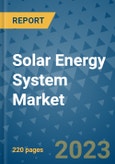In recent years, the increasing focus on environmental pollution and damage has prompted governments worldwide to take decisive actions towards supporting sustainable and renewable energy sources. Solar power has emerged as one of the most abundant and long-lasting sources of clean energy. Subsidies for manufacturers, incentives for customers, and technological advancements have further enhanced the feasibility of solar power. The explosive demand for solar cells, the rise of rooftop installations, and the advent of cutting-edge solar photovoltaic (solar PV) technology are propelling the growth trajectory of the global solar energy system market. With growing energy needs and rapid urbanization, this momentum is expected to be sustained in the foreseeable future, leading to substantial growth in the solar energy sector.
The global solar energy system market is witnessing robust growth, driven by the increasing demand for clean and sustainable energy solutions. Solar power is becoming a favored choice across various sectors due to technological advancements and supportive government policies. The report by [Your Company Name] promises to provide valuable insights into the growth and trends of the global solar energy system market.
Promising Technological Improvements Drive Solar Energy System Market Growth
In response to the worsening environmental challenges and the impacts of climate change, government bodies and environmental agencies are actively promoting the viability of solar power. As a result, there has been a significant decline in the pricing of solar power systems, coupled with remarkable improvements in their performance and efficiency in recent years. These factors have generated significant momentum, driving the demand for solar energy systems across commercial, residential, and industrial sectors. The adoption of solar power is expected to rise in tandem with ongoing technological advancements, further fueling the expansion of the global solar energy system market.Explosive Demand for Solar PV Panels Presents Substantial Opportunities
The unprecedented surge in demand for solar photovoltaic (solar PV) systems is a testament to the promising prospects in the global solar energy system market. Continuous technological innovations in solar PV have placed it ahead of other renewable sources, including wind and hydropower. This trend is evident in both developed and developing economies, driven by cost reductions in products and installations, as well as the growing environmental awareness globally. Solar PV systems are rapidly moving towards achieving economies of scale, contributing to the overall sales growth of solar energy systems in the foreseeable future.Asia Pacific Leads in Solar Energy System Adoption
Asia Pacific is positioned to dominate the solar energy system market, driven by increasing investments in renewables and a growing number of large-scale solar power plants in the region. The soaring electricity demand, improving standard of living, and high solar exposure further support the business opportunities in the regional solar energy system market. Key economies such as India and China are actively promoting the demand for solar PV panels through supportive policymaking and incentives. Meanwhile, Europe is also emerging as a notable market region, witnessing a rise in the installation of cutting-edge solar power plants.Key Market Players
Competitive players operating in the global solar energy system market include Sunpower Corporation, Acciona S.A., Abengoa SE, Esolar, Inc., Canadian Solar, Inc., Kaneka Corporation, United Renewable Energy Co. Ltd., Wuxi Suntech Power Co., Ltd., Tata Power Solar Systems Ltd., and Brightsource Energy, Inc.The global solar energy system market is witnessing robust growth, driven by the increasing demand for clean and sustainable energy solutions. Solar power is becoming a favored choice across various sectors due to technological advancements and supportive government policies. The report by [Your Company Name] promises to provide valuable insights into the growth and trends of the global solar energy system market.
Table of Contents
1. Executive Summary
2. Market Overview
3. Global Solar Energy System Market Outlook, 2018 - 2030
4. North America Solar Energy System Market Outlook, 2018 - 2030
5. Europe Solar Energy System Market Outlook, 2018 - 2030
6. Asia Pacific Solar Energy System Market Outlook, 2018 - 2030
7. Latin America Solar Energy System Market Outlook, 2018 - 2030
8. Middle East & Africa Solar Energy System Market Outlook, 2018 - 2030
9. Competitive Landscape
10. Appendix
Companies Mentioned
- Solar PV Manufacturers
- JinkoSolar Holding Co. Ltd. (JKS)
- JA Solar Holdings
- Trina Solar
- Hanwha Q Cells
- Canadian Solar
- Longi Solar
- Battery Manufacturers
- CATL
- BYD Company Ltd.
- Samsung SDI Co., Ltd.
- LG
- Panasonic
- Inverte
Methodology

LOADING...








